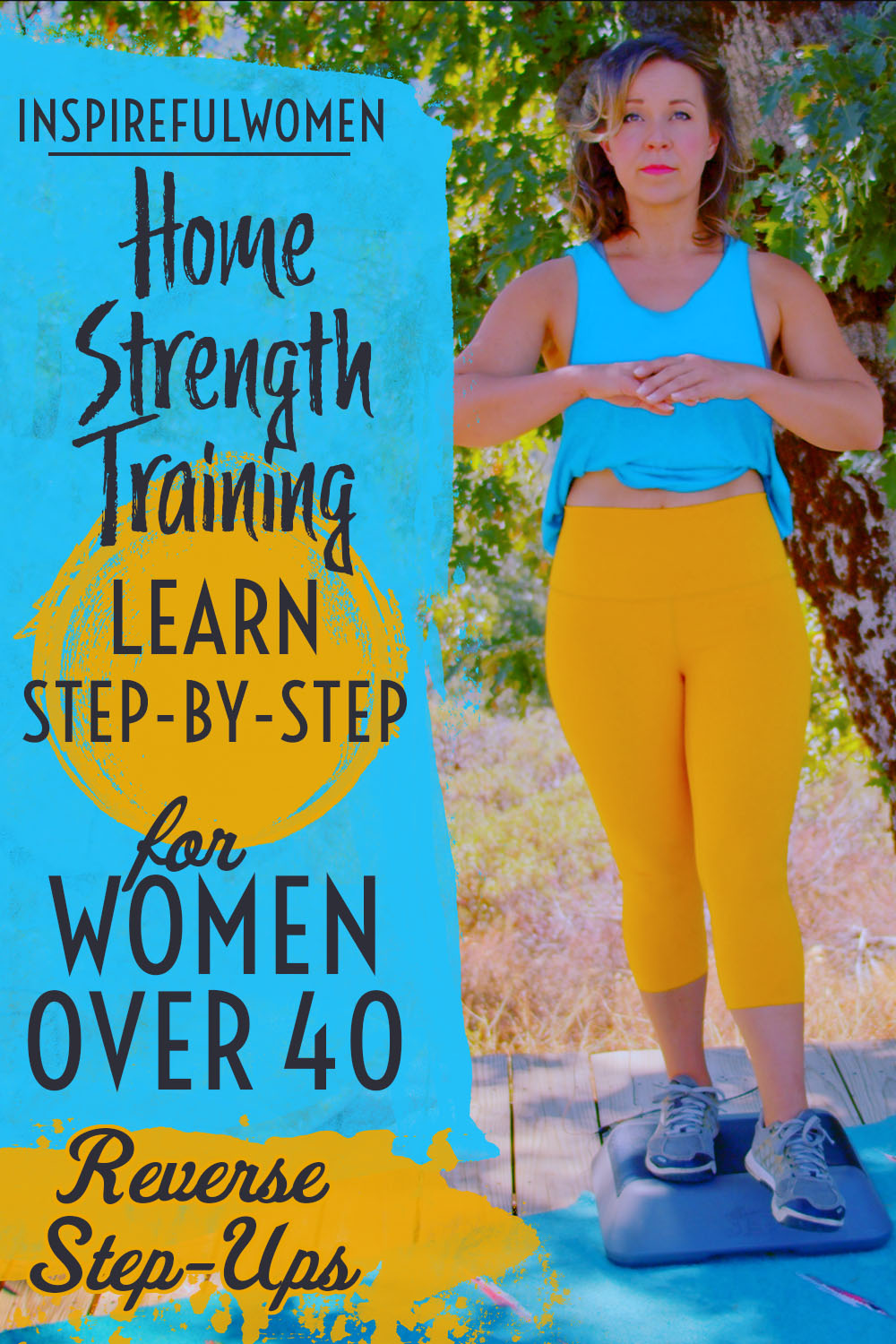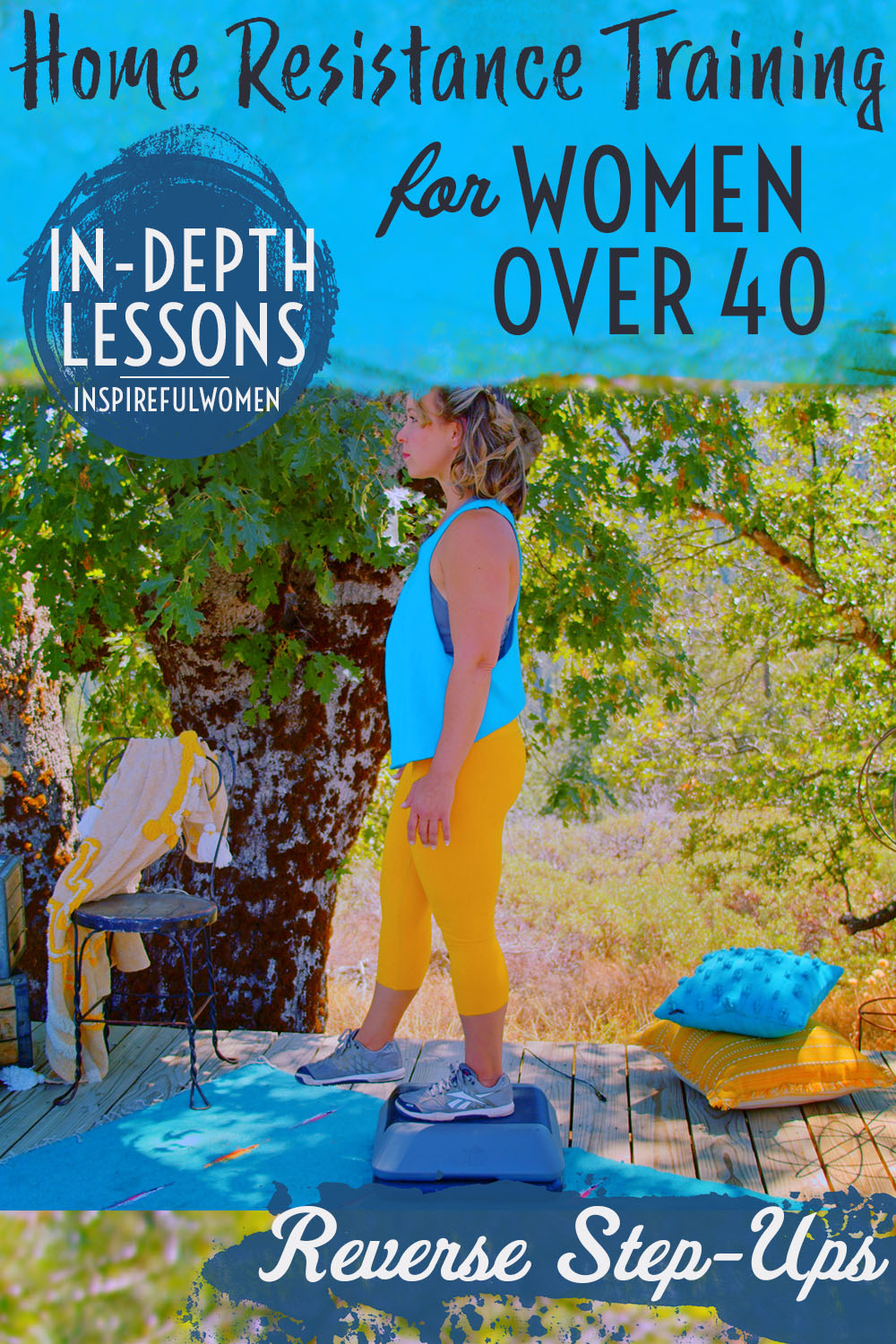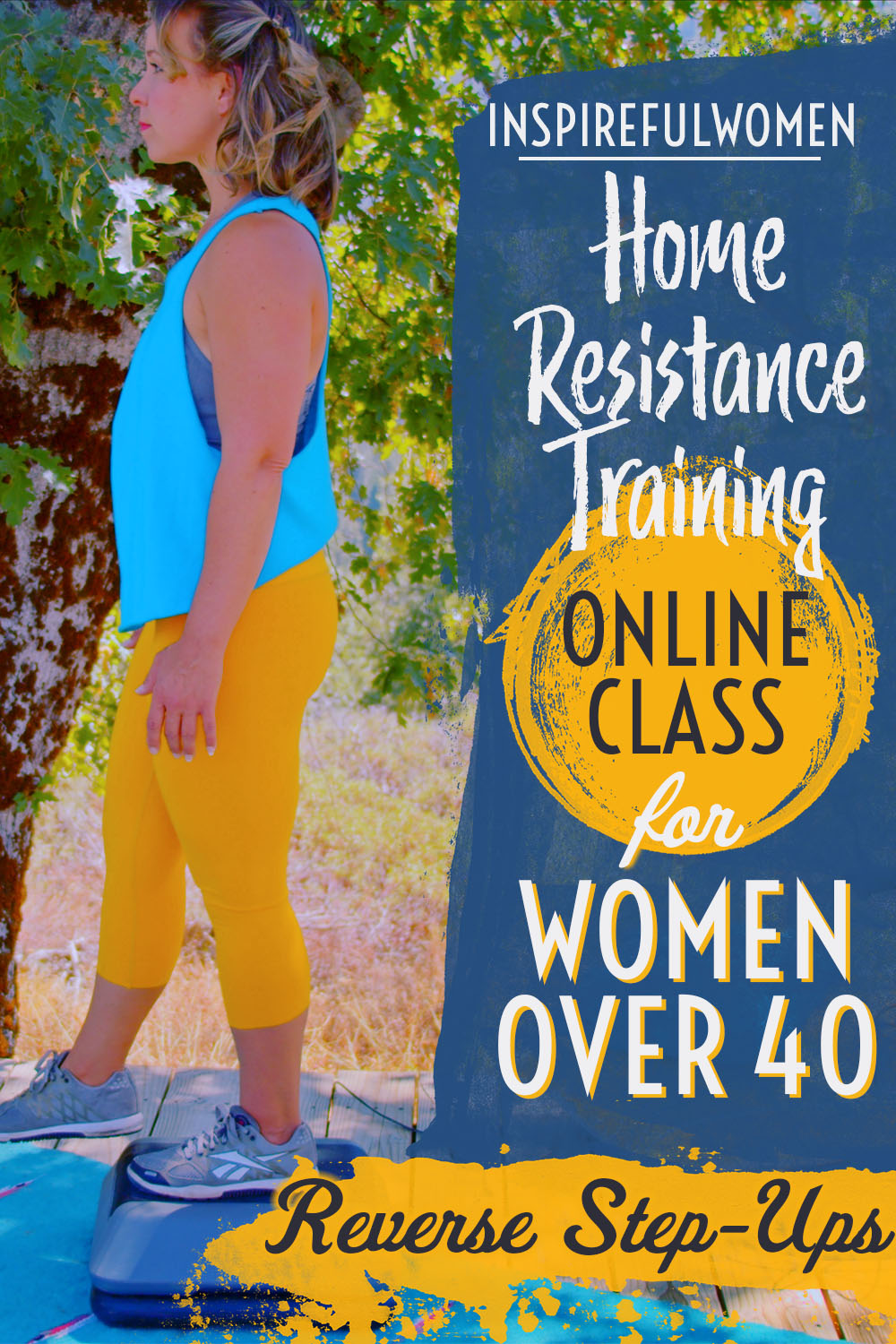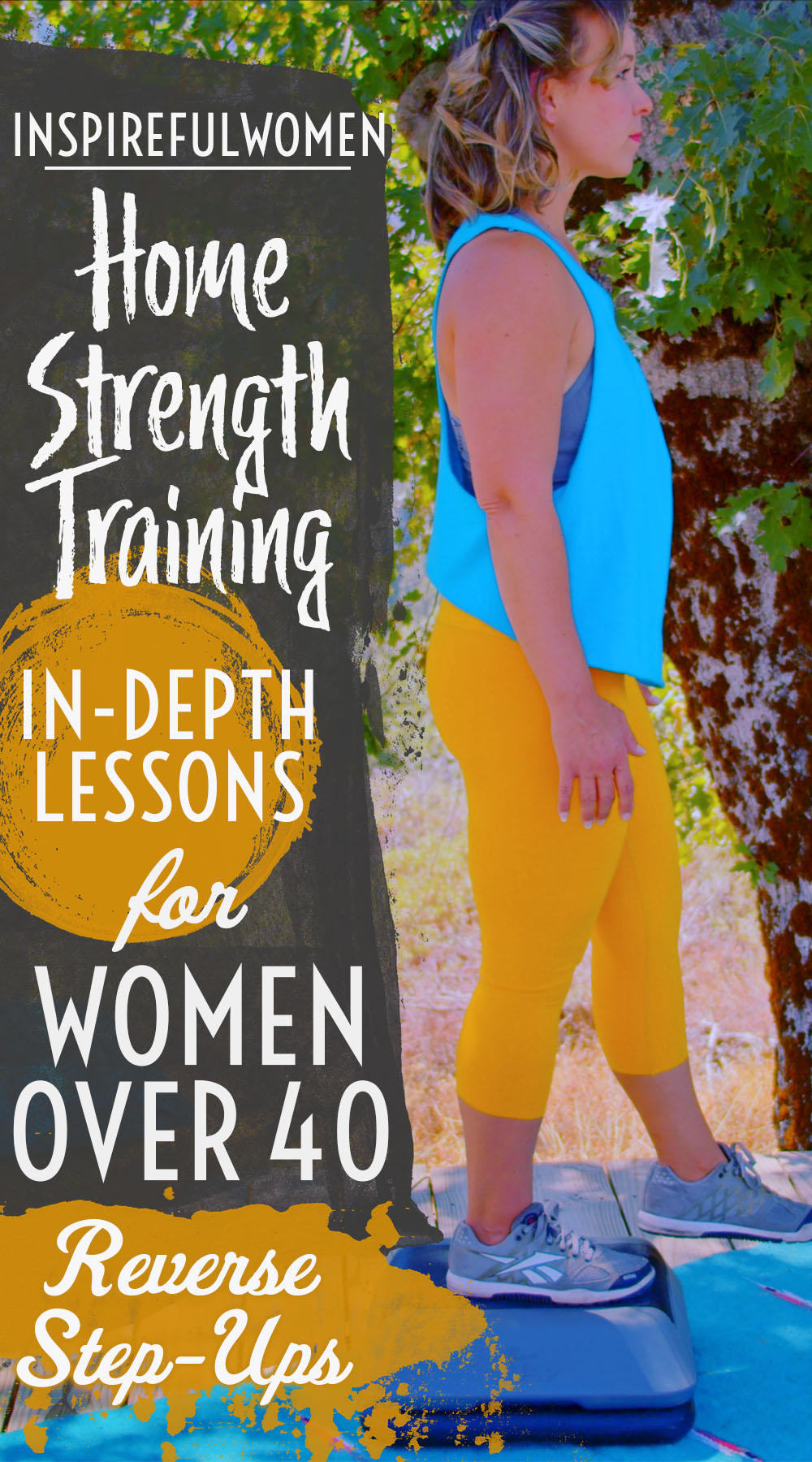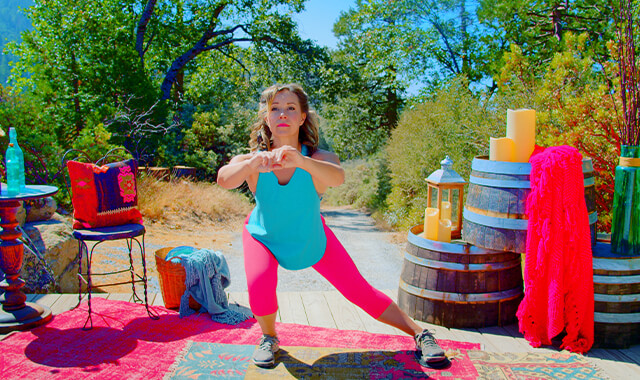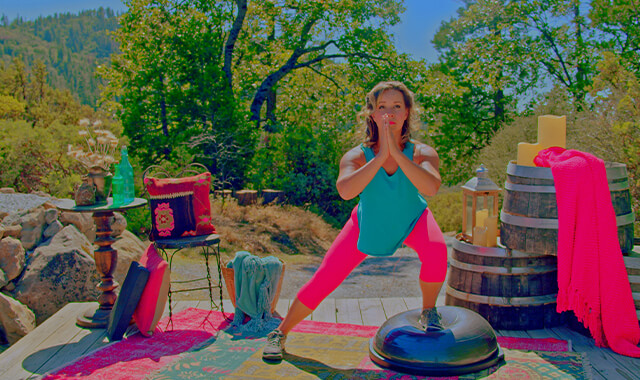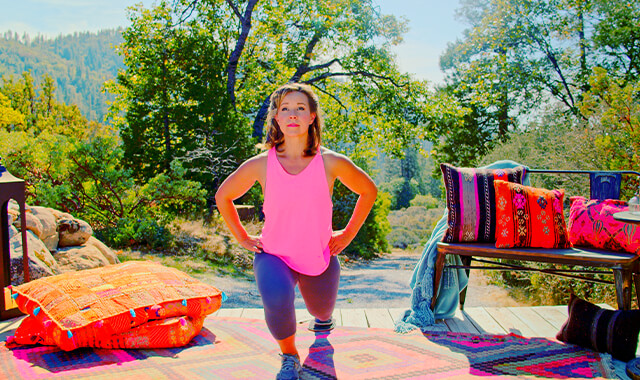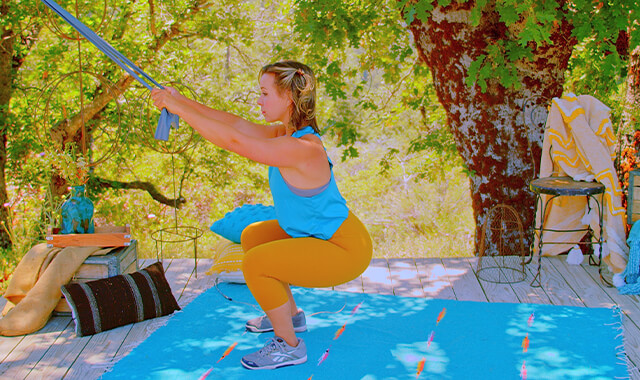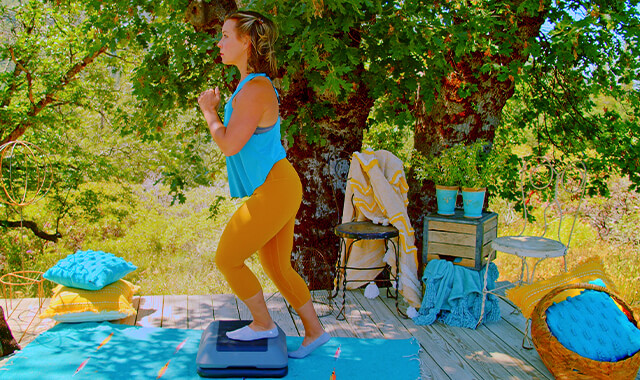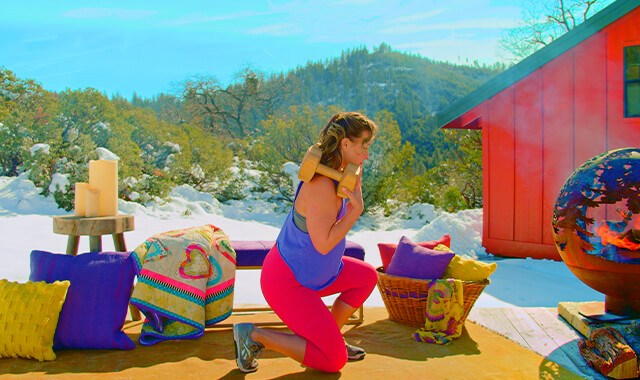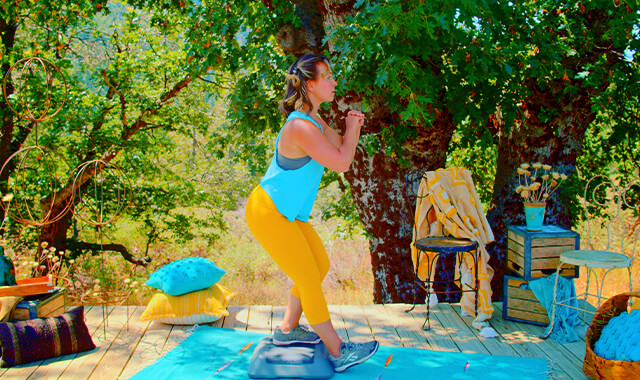Reverse Step Ups
How to Do the Quadricep Exercise - Backward Step Up at Home | In-Depth Guide [VISUAL LEARNERS] Beginner
Proper Form & Variations | Home Resistance Training
WHAT DO YOU WANT TO SEE?
QUICK DEMO
QUICK DEMO
MUSCLES THIS WORKS
MUSCLES
MAIN MUSCLES WORKED IN Reverse Step Ups
Quadriceps & Gluteus maximus
OTHER MUSCLES WORKED:
- Hamstrings
- Gastroc & Soleus
- Gluteus medius & minimis
STARTING POINTERS
Starting Pointers
WHAT WE'RE DOING TODAY
Other names for this exercise: Backward Step Ups
Reverse Step Ups are great for targeting the quadricep muscles. There is not much movement happening at the hip, nearly all of the movement comes from the knee. All muscles are weakest when they are in their shortest or longest position, and strongest in their midrange. The reverse Step Ups targets the quadricep muscles when they are at their shortest - getting the knee completely straight. This is also the position where there is the most compression between the kneecap and the thigh bone (femur). It is important that all 4 of the quadricep muscles are working together to keep the kneecap positioned correctly to avoid rubbing on the femur. The muscles that cross the hip will be working to help keep the hip stable, while the quadriceps straighten the knee. The focus is on coordinating the activity of the quadriceps muscles to control the movement of the knee. This exercise is frequently used in physical therapy to help increase the stability of the knee for those with painful or easily aggravated knees. This is a great exercise to get you ready for skiing and hiking.
HOW TO DO THE EXERCISE
LOOKS
HOW Reverse Step Ups SHAPE OUR BODY
Toned buttocks, and thighs (front and back). Works the muscles needed for healthy upright posture.
PROPER FORM
PROPER FORM: Reverse Step Ups
EQUIPMENT, SETS & REPS
EQUIPMENT
Step-Up
Small one with several heights for space saving:
Goes from 2-12" high & you can buy extra risers for it (I did) - they are the standard riser used with all the other regular step-ups that are a longer length, so any will do.
Extra risers - set of 2 will give you 4" extra for 16" height total.
The the only thing you might have a little trouble with with this one is doing a hip thrust on it (where you're back is on the step) - but it CAN work.
About 6-8 inches to begin. The weight must be on the ball of the foot - not the toes.
SUGGESTED STARTING WEIGHT FOR WOMEN:
Bodyweight
SETS & REPS:
2 sets of 8 reps
PACE:
Slow and controlled throughout.
BODY POSITION
BODY POSITION FOR THE Reverse Step Up
FEET: Stand in front of the step, facing away from the step. Feet parallel, normal stance distance apart (usually a few inches). Feet flat, toes forward. Place the ball at the foot of your working leg on the step behind you. The ball will be close to the edge of the step. The heel is lifted.
BODY STANCE: Neutral spine, lift sternum, shoulder blades down and inward. Hips and shoulders level and square to the front. Your shoulders and hips are lined up over your “non-working” leg (the one on the floor).
ARMS: Relaxed by your side or hands on the top of your pelvis or at hip creases to monitor form.
HOW TO DO
HOW TO DO Reverse Step Ups
CUE: You will be lifting the weight of your body up onto the step.
Slowly straighten your knee as you push your heel down onto the step and pull your body up to the step. Keep your ankle neutral as you lift and lower your non-working leg (the heel and toes lift off and touch down at the same time). Straighten your knee all the way.
When you are on the step, your shoulders should be lined up over your hips and over the foot of your working leg.
The non-working leg will remain out to the front of the step - it comes up as your body is lifted up but do not bring it back to the step - leave it out in front.
Keep your pelvis and shoulders level and square to the front. Slowly bend at your knee to lower yourself down again.
The foot of your working leg remains on the step. All of your weight is on the leg that is on the floor.
Repeat for the desired number of reps.
ankle, knee, and hip. Make sure that your knee and hip are fully extended at the top of the movement.
Keep your non-working leg held out to the side and continue with the next rep.
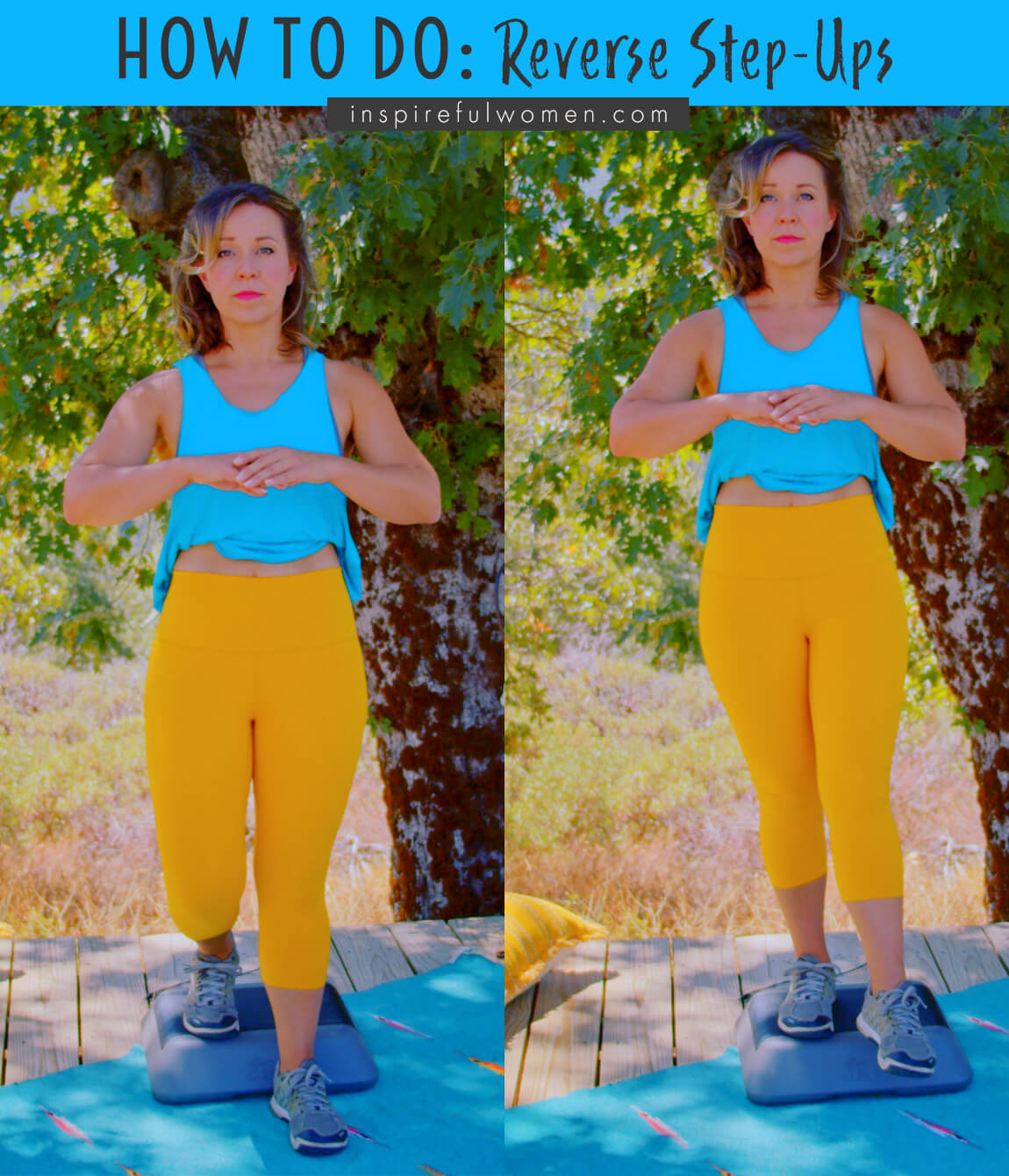
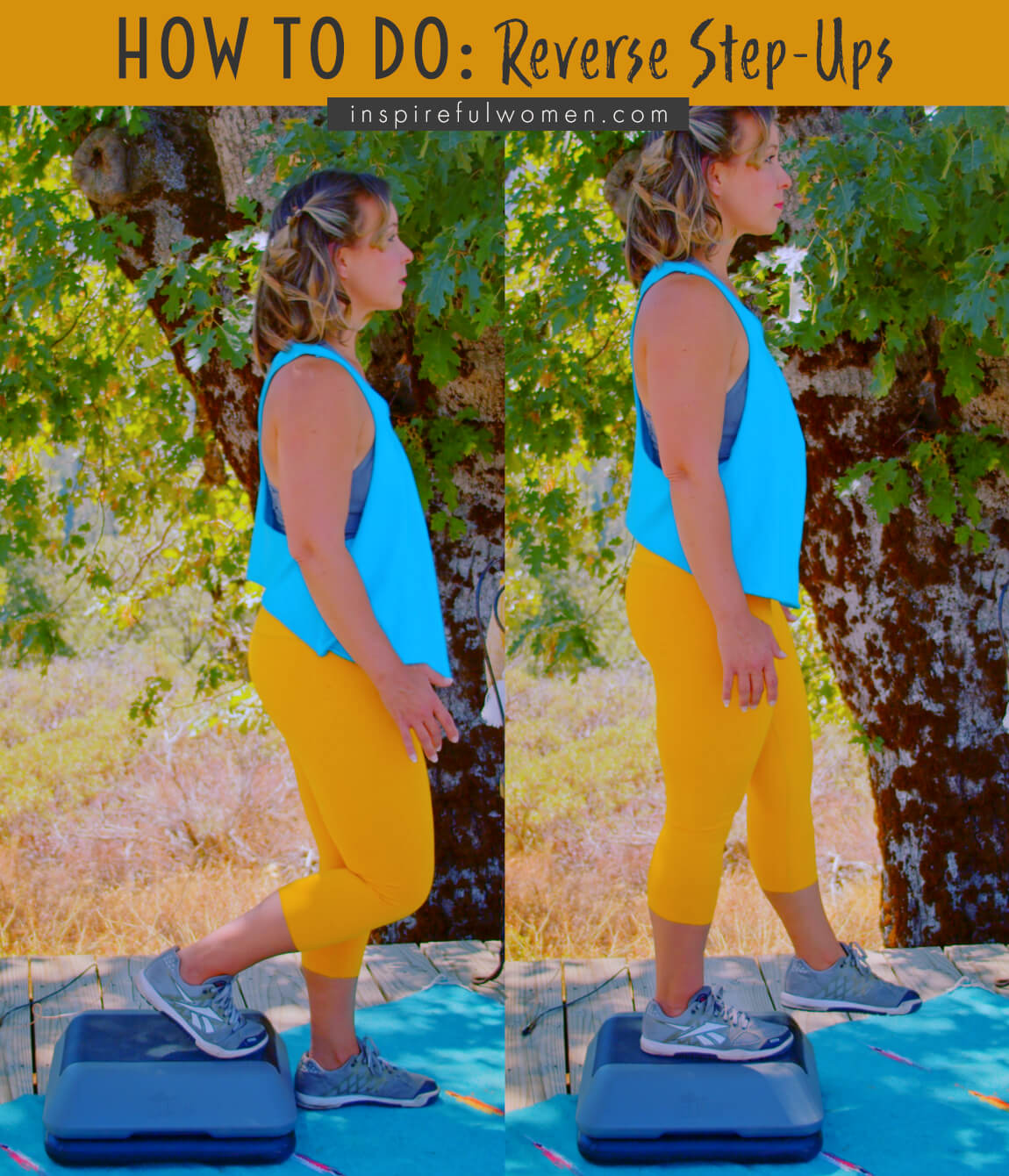
VARIATIONS
VARIATIONS
VARIATIONS OF Reverse Step Ups
WHAT WE'RE DOING TODAY
WHAT & WHY
BENEFITS OF TRAINING THE Quadriceps & GLutes muscles
WHAT
STEP UPS OR STEP DOWNS?
First, let’s talk about the naming of these movements. In step ups and downs the muscles are working as you step up AND as you step down. You will find that the names of the movements vary quite a bit. What one person refers to as a forward step up may also be called a reverse step down, etc. This can be confusing but, the naming is just opinion, most likely based on what the focus of the exercise should be - the up phase of the down phase. For the purpose of our naming, there are a few ways to sort through this.
If you are behind the step, facing the step as you would walk upstairs, it makes sense to call that a “step up” position. If you are in front of the step or on the step facing away from the step, as if you were walking downstairs, it makes sense to call that a “step down” position.
If you start on the floor and step up onto the step first and then step off of the step, that could be thought of as a step up. And, likewise, if you start on the step and begin the set by stepping down to the floor, that could be a step down exercise. That helps to clarify the movement when you are facing toward or away from the step. When you are standing sideways on the side we will just call that one “Lateral Step Downs” because you begin the movement from the top of the step.
Like most exercises, this movement works the same muscles throughout the entire movement, both as you are stepping up and as you are stepping down. The muscles are worked in two different ways. For example, during a forward step up, the targeted muscles shorten (concentric contraction) to extend the leg and lift the body up onto the step. The same muscles contract as the muscle is lengthening (eccentric contraction) and the body is lowered back down to the floor. It is fairly common to forget this when you are doing step ups, and let gravity just pull down back down to the floor. Lower yourself back down slowly and with control.
Step ups and step downs are a group of exercises that work the knee extensors and the hip extensors together. The knee extensors are the quadriceps muscles on the front of the thigh. The main function of these muscles is to straighten the knee. The main hip extensors work to straighten the hip, they are the gluteus maximus and the hamstrings. In these exercises, you will be stepping up or down off of a box or step. Different versions of the exercise will face different directions - towards the step, away from the step, or sideways. Even though the same muscles will be working in all of the exercises, it is surprising how just changing the direction of the stepping feels very different.
Step ups and downs will help to strengthen the leg muscles. But, the main focus of these exercises is learning good form - motor control, balance, and stability. It is pretty easy to make these exercises easier or harder. But first, it is important to make sure your form is correct. Although we are very used to going up and down stairs, it is fairly common to use gravity and momentum to help you. Learning the correct form helps to train the muscles of the core to hold your torso still as you use the leg to move your body. Going up and down stairs the correct way will strengthen the leg muscles and prevent straining the back, not just in exercise, but in daily life. Try to resist the urge to use a taller step and sacrifice good form.
Pay close attention to the alignment of your foot, ankle, knee, hip, and pelvis during these exercises. Even the muscles of the feet will be working. Try to keep the leg as still as possible (not wobbly). It is tempting to think about lowering the non-working foot to the floor instead of thinking about bending the ankle, knee, and hip of the working leg. Although it seems like a small thing it makes a big difference. When you give your brain the task of lowering the non-working foot to the floor, it will want to do it the easiest way possible, which is to let gravity pull that side of the hip down. It is not necessary to tap the non-working foot on the floor. Avoid lowering down past the point of being able to maintain good form. The goal is to go as low as you can while maintaining good form.
WHY BOTHER DOING IT?
WHY
WHY DO WE EVEN CARE?
TRAINING EVERY DAY LIFE STRENGTH
There are many good reasons for including step ups and downs in your exercise program. These exercises train you to use your body the way it was designed to be used. The goal of the exercise is to hold the torso in a neutral position and still as you use your leg to move your body up and down. This is exactly how we should be moving in many daily activities. Working on keeping the legs and spine in good alignment, while moving through the ankles, knees, and hips will strengthen the muscles of the torso and the legs with the least amount of stress on all of the joints.
SINGLE LEG EXERCISES GREAT FOR BALANCE & STABILITY
This movement is done one leg at a time. Single leg exercises have the added benefit of training balance and stability. All of the muscles in the foot, and those that cross the ankle, knee, and hip will have to work together to keep the lower limb aligned and stable. Good alignment of the lower limb reduces the stresses on the joints to help to prevent age-related changes. Common age-related changes include muscle imbalances, joint surface wear and tear (osteoarthritis), decreases in range of motion, and increased risk for falls.
Single-leg exercises can help make you more aware of any left and right differences in the range of motion of the joints, leg strength, or ability to balance. If you find that you are more limited on one side, work on that side a little bit more to try to correct the differences. Keep in mind that in single leg exercises, the working leg is moving 100% of your body weight.
EVERYDAY LIFE
EVERYDAY LIFE &
MUSCLE FUNCTION
HOW WE USE OUR Quadriceps and Gluteus maximus IN EVERYDAY LIFE
THE QUADRICEPS STRAIGHTENS THE KNEE AND THE GLUTEUS MAXIMUS STRAIGHTENS THE HIP DURING:
- Climbing upstairs
- Climbing a ladder
- Walking uphill
- Getting up from a squat
- Pushing up from the floor
- Rising from the toilet or chair
- Stepping into a high vehicle
THE QUADRICEPS HELPS TO CONTROL THE BENDING OF THE KNEE AND THE GLUTEUS MAXIMUS HELPS TO CONTROL THE BENDING OF THE HIP DURING:
- Going down stairs
- Going down a ladder
- Walking downhill
- Lowering down into a squat
- Getting down to the floor
- Lowering down to the toilet or chair
- Climbing out of a high vehicle.
SCIENCY STUFF
SCIENCY STUFF
SPIFFILICIOUS FACTS ABOUT MUSCLES & MOVES
The musculoskeletal system is the body’s system that is responsible for movement. The parts of the system work together as a whole. The brain programs the movement patterns and along with the nerves, orchestrates out all voluntary movement. When the parts of the system (joints, muscles, nerves, soft tissues) are healthy, each part does its job. The movement will put the least amount of stress on all parts of the system and will use the least amount of energy to achieve its task. But, even small amounts of weakness, pain, instability, or lack of motion can affect the entire system. For example, restricted ankle movement will affect the movement at the knee, hip, pelvis, and spine. The brain must reorganize the movement pattern to adjust for the deficit. This is known as compensatory movement patterns.
Compensatory movement patterns can lead to new problems in other parts of the system. When you ask your body to work in a way that it was not designed to work, it usually cannot accomplish the task without causing increased stress and energy requirements. Step ups and downs work the entire lower body together. All parts need to do their job effectively in order to safely complete the movement. This exercise is frequently used as a way to identify and address areas of weakness. The focus of the exercise is on form and control. It is important to keep the entire lower limb, pelvis, and spine aligned during the movement. Mastering step-ups and downs will help to reinforce healthy movement patterns that are used in many daily activities.
ALLLL MUSCLES & WHEN
ALL MUSCLES WORKING & WHEN DURING THE Reverse Step Up
Core stabilizers: transverse abdominis, obliques, quadratus lumborum, iliopsoas all work to hold the core stable. This is a single-leg exercise so the hip abductors will be active to hold the pelvis level. The hip, knee, and ankle joint stabilizers are active when the leg is loaded (body weight).
In the beginning position, the “non-working” leg is on the floor and supports the body weight. The ball of the foot of the working leg is on the step behind you. The heel of the working leg is pressed into the step, the quadriceps work concentrically to straighten the knee as the gastroc and soleus contract concentrically to pull the tibia (lower leg bone) back to align it over the ankle joint. As the heel is being pushed down the weight of the body is being lifted up off of the floor. The muscles of the hip, knee, and ankle joint work together for balance, stability, and control of the ankle as the knee straightens and the weight is transferred from one leg to the other.
To lower the body down to the floor - The muscles work together to stabilize the leg as they contract eccentrically to decelerate the weight of the body as it is pulled down (gravity) to the floor. The quadriceps femoris controls knee flexion, and the calf muscles control the ankle bends (dorsiflexion).
PIN IT FOR LATER!

